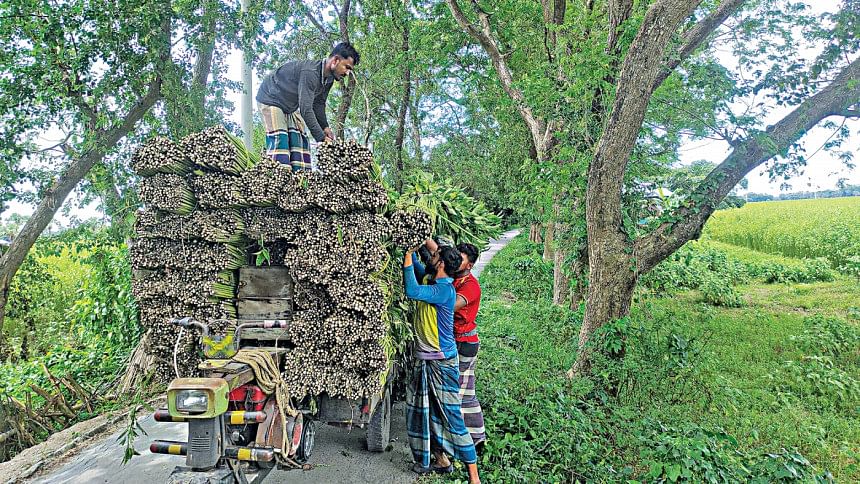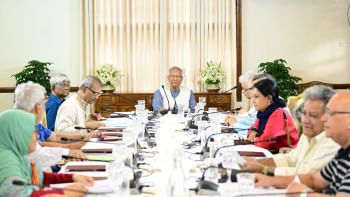Lower rainfall spells trouble for jute farmers

Though the monsoon is just two months in, there has been lesser rainfall than usual this year, leading to apprehensions among jute growers in Faridpur and Rajbari over finding water sources for retting.
Lying some 120 kilometres or so west of the capital, the two adjoining districts are major hubs for jute cultivation. The crop is planted from early March to early May and harvested from July to September.
Some 7,38,580 bales (one bale equals 180 kilogrammes) of jute were produced in Faridpur while 4,84,135 in Rajbari in fiscal year 2020-21, according to the latest data available from the Bangladesh Bureau of Statistics.
This can be better brought into context with the fact that around 77,25,083 bales were produced around the country that year.
This year the expectation from Faridpur is 12,22,280 bales while Rajbari 6,81,250 bales.
But Dhaka division, under which the two district are situated, received 326mm of rainfall in June whereas the usual is around 361mm. July's figures are expected to be around 330mm to 405mm whereas the average is around 376mm.
Hence the prospects are gloomy for the rest of the monsoon till September. This is because water is an essential part of the extraction process of jute.
The plants have to undergo retting, a process involving submerging them in stagnant or slow-moving waters for about 8 to 14 days, depending upon water temperature and mineral content.
This lets bacteria and moisture rot away much of the cellular tissues, facilitating separation of the fibre from the stem.
But the lower rainfall has led to a reduction in the number of water bodies available for the purpose.
Farmers have been found to have left their harvested plants on the fields in villages under Sadarpur, Nagarkanda and Saltha upazila in Faridpur and Baliakandi and Sadar upazila in Rajbari.
Those who are opting for water bodies some distance away from their crop fields are having to pay each farmhand Tk 700 to Tk 800 per day, which is Tk 200 to Tk 300 higher than the usual.
Farmer Hafizur Fakir of Senati village under Saltha upazila said to have invested Tk 75,000 on three bighas of land buying seeds, fertilisers and pesticides and farmhand wages.
"Due to a lack of rainfall, I could not get retting done of plants on one bigha of land," he told this correspondent.
Another grower, Saheb Sheikh, said his jute plants did not grow that well and he harvested just two out of five bighas for the lack of water.
Farmer Babul Sheikh of Khoargarm said they were incurring higher production costs for having to use water pumps to source the required water.
"In other years, water enters our land at the end of June. But the situation is totally different for two years as there has been a water crisis," said farmer Promath Chandra Mondal of Bastoputi village under Nagarkanda upazila.
Farmers fear that if the present situation persists, they might incur huge losses as quality fibres cannot be extracted without proper retting.
Due to a lack of water, farmers are having to repeated use the same water bodies, said jute trader Arifurjaman Chan of the Kanaipur bazar.
This leads to a loss of colour and quality and farmers get Tk 400 to Tk 500 less per maund (around 37 kilogrammes), he said. Locally jute is currently selling for Tk 2,600 to Tk 3,000 per maund.
The situation was acknowledged by Md Ziaul Haque, deputy director of the Department of Agriculture Extension (DAE) of Faridpur.
"We are helping 72 jute famers in our district create ditches so that they can get their jute retting done, although it is not enough," said Md Zahidul Islam, assistant director of the Directorate General of Jute in Faridpur.
"We have asked to adopt the ribbon retting method (which requires less water) but farmers are reluctant as they cannot avail jute sticks which fetch good prices," he said.
"We have held discussions with Bangladesh Water Development Board to open sluice gates…I hope the problem will be solved," he added.

 For all latest news, follow The Daily Star's Google News channel.
For all latest news, follow The Daily Star's Google News channel. 



Comments